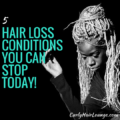There was a time in my life when I looked in the mirror and wondered why did I have to inherit my mum’s genes, why was my hairline so thin? Being a teenager at the time, it was like the end of the world to me (it wasn’t really, now I know!). Nevertheless, at the time, I was young and conscious of every little flaw I saw starring back at me in the mirror. It was only when I started transitioning to natural hair that I discovered I had thinning hair edges, clinically named traction alopecia.
Traction alopecia, or thin edges, is described as a recession of the hairline caused by hair loss. There can be many causes and severity stages for it, and in my case, I was the one to blame. I did my best to always have my hair in place whether it was by relaxing it, tying it down, slathering cream or brushing it down, it could be one or more combinations of these. Having new hair growth or hair out of place framing our face was often reminiscent of nappy, kinky hair. A sight that was not desirable at all, which lead me to harmful practices. Can you see yourself in any of this?…
Anyway, my teenage angst was never short of “end of the world” crisis, so I can’t say I was “traumatised” by the experience, but for many women, it can certainly be a different situation as thin edges can progress to scarring and the need to resort to a hair transplant. Feeling self-conscious, embarrassed, puzzled and anxious about what is happening and what you can do to stop it are some of the emotions we can have while living through this.
I hope this is not your case, but in case it is I’d like to give you a few scenarios where thin edges are a recurrent thing. Continue reading and you’ll be able to download the FREE WORKSHEET GUIDE to help you identify behaviours that are causing you, or can potentially cause you, thinning hair edges.

Whether you’re planning to start, or have started, your transition to natural hair I know you want this journey to be a successful one. What I share here with you is from my own experience, and I can say that ever since I started my journey I noticed new growth in my hairline and is as it never was (at least, from when I started relaxing). This is due to a combination of things, but initially by not engaging in behaviours that were detrimental to my hair and scalp. By paying attention to the different signals I’ll share with you here, I hope you can avoid developing or increasing a “hairless” problem.
CAUSES OF THINNING HAIR EDGES
1| Chemicals
Frequently relaxing and dyeing hair leaves it weak as these products have strong chemicals that act on the internal structure of the hair to permanently change it. My weapon of choice was the relaxer, and over a period of time with constant and/or excessive use the hair becomes vulnerable and weak, and this coupled with other damaging practices and conditions lead to hair breakage and a receding hairline.
2| Tight Hairstyles
This is something I used to do quite often whenever I tied my hair down in a bun or ponytail, but tight flat braids or flat twist, are also included. I loved to see my hair perfectly smooth close to my scalp. It was like, outfit? Checked! Shoes? Checked! Hair? Double check! Man, I had it all controlled. Except I didn’t, and if this is something you do please stop it. All this pulling and tugging will do your hair no good.
3| Hair Extensions
Loc extensions, braid extensions, twist extensions and hair extensions can all cause thinning edges if applied too tight around the front edges, if they’re too small or even if they’re too big, weighing down and causing thin hair and breakage. To top this up, even the application method of some weaves is detrimental to the health of your hair and scalp since a chemical glue can be used to bind them together, which honestly sounds bad and will certainly look worse in the future if not avoided at all costs.
4| Manipulation
So you like to change it up, run your finger through your hair and maybe even smooth it down with a brush. Your hands will inevitably end on your hair no matter what. You just can’t seem to control yourself, is it? If this is you might as well start to, because all this hair stroking, hugging and brushing if not restrained will show itself on your edges and not in a good way.
5| Health Conditions
In this situation, things are a little bit out of your control. Postpartum, sudden weight loss, stress, chronic diseases such as lupus or certain types of medication can have a direct impact on your hair’s condition and, in this case, you’ll need to monitor your hair and seek professional when you notice changes. Your doctor might be able to adjust or change your medication, prescribe some supplement or initiate a course of treatment if you’re experiencing a severe case of traction alopecia.
6| Hair Products
Yes, it’s true. Not all hair products are made the same way. Many naturalistas prefer products that are natural and organic and this is excellent, but for others, this is not a pre-requisite, and it doesn’t have to be. However, some products have ingredients that are damaging to our hair and scalp’s health such as drying alcohols, petrolatum or mineral oil. Pay attention to the ingredients! Oh, and don’t forget your makeup too. It’s not exactly a hair product, but it has ingredients that are not supposed to be on your hair so don’t get them too close to your hairline.
7| Friction
We may not be aware of it, but oftentimes friction can damage our edges. If you use headbands, helmets, beanies, hats, caps or anything that holds around the hairline make sure it’s not too tight, or that any elastic part is not resting on your hair sucking moisture away and pulling hairs. There are a lot of hair accessories that are lined with satin and will be gentle on your hair like Grace Eleyae‘s caps for instance.
If you see yourself in any of these situations or want to avoid them altogether, you can DOWNLOAD the FREE WORKSHEET GUIDE below to help you. I created this simple and easy guide to get you thinking about practices and behaviours that can lead you to develop thin edges. If you have thin hair you need to be even more vigilant as your hair is less resistant to tension.
With this worksheet guide, you’ll have 3 different sections – Manipulation, Tight Hairstyles & Hair Extensions and Products – where you’ll be able to go answer a few questions in different scenarios for you to access what you could be doing wrong. There is also a section at the end with some tips on what you can to address the problem and space for you to create your action plan.
Click now, to have access to this worksheet. This is not only suited to those who have thinning edges or think they have them. This is worksheet is also good for you if you’d like to put your practices in check and confirm if you’re on the right path. Take the time to answer the questions, and if you believe you have a problem develop your action plan. Avoid feeling anxious while trying to revert a problem that will take time to heal (regrow)! See you in my next post. Take care of your hair and spoil it with love!







